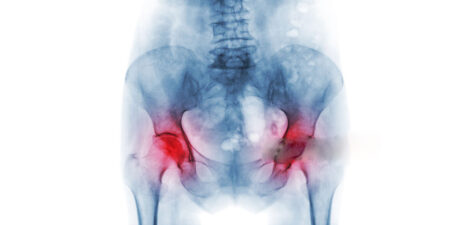History and MRI findings: during a league match, the football player received a
kick on the medial malleolus of the right ankle, resulting in a supination injury.
On MRI, both the anterior talofibular and calcaneofibular ligaments were no longer constantly defined and there was a marked high-signal swelling of the surrounding soft tissue. Mild joint effusion in the tibiotalar joint. Hyperintense bone marrow oedema in the medial talus and dorsomedial and dorsolateral tibial epiphysis.
Treatment
The player received initial treatment on the pitch using the RICE method. As acute treatment he also received 600 mg oral ibuprofen as required, forearm crutches to relieve the right leg from weight and provide pain relief and cold compresses to reduce swelling.
From day 2 after the initial injury, the patient wore an ankle brace with a compression component, lateral stabilisation and straps to reduce anterior translation of the talus.
Combination therapy with high-energy pulsed laser (λ = 905 nm and 300 W maximum output) was also initiated at this time to provide local pain relief in preparation for the radial shockwave therapy to allow application at a markedly higher energy intensity using a Swiss DolorClast machine (Electro Medical Systems; Nyon, Switzerland) and the EVO Blue handpiece. The treatment regimen was as follows: laser programmes for pain relief and absorption of oedema and shockwave application using a 36 mm applicator, frequency 20 Hz, 5000 impulses per session, 2 bars of pressure, applied over the lateral and medial malleolus areas to approximately the distal third of the lower leg and the anterior ankle area with the aim of pain relief and oedema absorption.
The patient was already without free of pain following the first combination therapy session in conjunction with the cold applications mentioned above. At the same time, upper body and trunk training was also initiated to maintain physical fitness.
The above combination therapy was performed daily, followed by cold compression using a therapy machine and bandages, until day 5 after the initial injury. After the third therapy session with laser and rESWT, there was no longer any swelling in the ankle joint and full weight-bearing without support was possible.
Between day 6 and day 18, therapy was continued 3 times a week as follows:
- laser programme for pain relief in preparation for rESWT
- applied with a 15 mm applicator, frequency 20 Hz, 4500 impulses per session applied to the tears. The pressure was increased in the further course from 2.0 bar to 3.0 bar. Treatment was followed by
2 x 3-minute cold therapy with Cryolight. - applied with a 36 mm applicator, frequency 20 Hz, 4500 impulses per session, applied over the surrounding lateral malleolus area. The pressure was increased in this area in the further course from 2.5 bar to 3.2 bar.
From day 6 after the initial injury, it was already possible to initiate relaxed cycling, i.e. low linear weight-bearing for collagen alignment, and from day 10 simple ankle stabilisation exercises. From day 12 post trauma, the player had his first running sessions with carefully managed jumping exercises and full taping around the ankle, depending on the RTA (return to activity) phase attained at the time.
Twenty days after injury, the player passed his RTS (return to sports) test and was permitted to carry out ball work, sprint training and lateral movement sequences with taping applied.
Laser and rESWT therapy over the injury site were continued in parallel as follows: pain relief programme with laser and rESWT, applied with a 15 mm applicator, frequency 20 Hz, 4000 impulses per session applied to the tear sites, 3.5 bar.
As part of the gradual increase in weight-bearing, the athlete was reintroduced to all aspects of team training before the end of week 4 post trauma, with taping applied. Having passed the RTC (return to competition) test on day 27 post trauma, the player was permitted to fully participate in team training without restriction, but with full taping applied. He played his first league match 34 days after his initial injury.

He received further treatment for 2 weeks as follows:
laser (pain relief programme) to prepare the tissue and rESWT applied with a 36 mm applicator, frequency 20 Hz, 4500 impulses per session, over the surrounding lateral malleolus area, 4 bar, with the aim of supporting full healing, the stability of the ligament complex and the absorption of the bone marrow oedema as secondary prophylaxis.
Conclusion:
High-energy laser and rESWT in combination are an outstanding method of providing effective and above all long-lasting treatment of injuries to the lateral ligament complex of the ankle. The major advantage of this method is the pain relief provided by the laser, which, unlike other medication, has no adverse impact on the effect of rESWT, but allows the energy intensity to be increased, thereby further enhancing its effect. This combination therapy can be equally used in a wide variety of indications, such as insertion tendinopathy, muscle injuries, fractures and many others.
Autoren
ist Heilpraktiker für Physiotherapie, Physiotherapeut, Manualtherapeut und Sportphysiotherapeut aus Augsburg, der sechs Jahre beim Fußballverein FC Augsburg (NLZ) gearbeitet hat. Er betreut die Augsburger Panther (1. Liga Eishockey). Seit Juli 2019 hat er gemeinsam mit seinem Geschäftspartner Ferdinand Merckx das Physiotherapiezentrum „Die Körperwerkstatt“ in Augsburg eröffnet, das auf Sportphysiotherapie spezialisiert ist. Er ist wiss. Beirat der sportärztezeitung.



